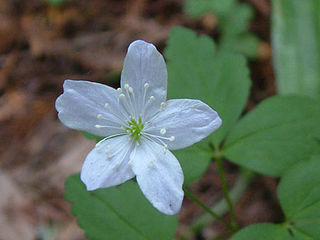
Anemonoides quinquefolia, a flowering plant in the buttercup family Ranunculaceae, is native to North America. It is commonly called wood anemone or windflower, not to be confused with Anemonoides nemorosa, a closely related European species also known by these common names. The specific epithet quinquefolia means "five-leaved", which is a misnomer since each leaf has just three leaflets. A plant typically has a single, small white flower with 5 sepals.

Dicentra formosa is a flowering plant with fern-like leaves and an inflorescence of drooping pink, purple, yellow or cream flowers native to the Pacific Coast of North America.

Thalictrum thalictroides, the rue-anemone, is a herbaceous perennial plant native to woodland in eastern North America. It has white or pink flowers surrounded by a whorl of leaflets, and it blooms in spring.
Veratrum insolitum is a species of false hellebore, a type of plant closely related to the lily. Its common name is Siskiyou false hellebore. It is native to the northwestern United States: Washington, western Oregon, and northwestern California as far south as Trinity County.
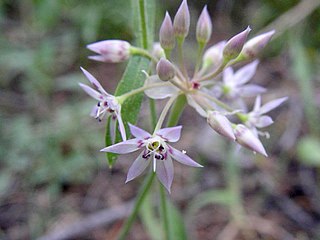
Allium campanulatum is a species of wild onion known by the common name dusky onion or Sierra onion. This is a flowering plant native to the western United States from southeastern Washington and northern Oregon to southern California, and western Nevada. The dusky onion grows in foothills and mountains, especially in dry areas, such as chaparral habitats.
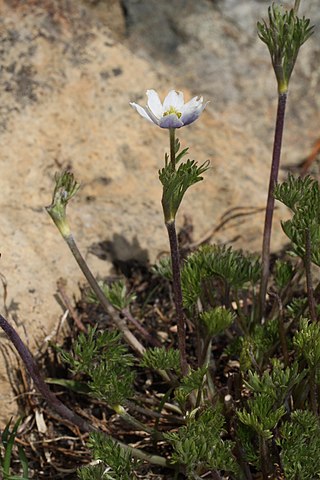
Anemone drummondii is a species of flowering plant in the buttercup family Ranunculaceae, known by the common name Drummond's anemone. It is native to mountains in western North America.
Erigeron cervinus is a North American species of flowering plant in the family Asteraceae known by the common names Siskiyou fleabane and Siskiyou daisy.

Gratiola heterosepala is a species of flowering plant known by the common name Boggs Lake hedgehyssop.

Guillenia lasiophylla is a species of mustard plant known by the common names California mustard and slenderpod jewelflower. It is native to western North America from British Columbia to northern Mexico. It can be found in a variety of habitats such as desert flats, gravelly areas, limestone rocks, talus slopes, sandy banks, and grassy fields. This is a thin-stemmed erect annual herb with long lobed, toothed leaves surrounding the base of the plant and smaller leaves lining the stem. The top of the plant is occupied by an inflorescence of flowers, each with widely spaced oval-shaped white or yellowish petals half a centimeter long. The fruit is a flat, narrow silique up to 7 centimeters long which hangs downward from the stem. Flowers bloom March to June.

Enemion occidentale is a species of flowering plant in the buttercup family known by the common name western false rue anemone. It is found in California and rarely in Oregon where it is a resident of forest, woodland, and chaparral habitats in many of the mountain ranges. This is a small perennial herb producing one or more erect, unbranched stems growing to maximum heights near 25 centimeters. Leaves appear toward the top of the smooth, naked stems. Each green cloverlike leaf is divided into usually three irregular lobes. The solitary flowers are petite with white to very light lavender petallike sepals and no petals. At the center are white stamens with yellow anthers and white styles with yellow stigmas.

Enemion are spring ephemerals with white flowers, branching stems, and finely divided leaves in the buttercup family. One species, Enemion biternatum, is native to eastern and central North America, while Enemion occidentale, stipitatum, hallii, and savilei are native to the West Coast of the United States and Canada. The genus Isopyrum is similar, and has species native to Europe and Asia.

Allium cratericola is a species of wild onion known by the common name Cascade onion. It is endemic to California, where is an uncommon member of the flora in several of the state's mountain ranges, including the northern and southern California Coast Ranges, the western Transverse Ranges, Klamath Mountains, and the Sierra Nevada foothills. Its range covers much of the state, from Riverside County to Siskiyou County.

Allium siskiyouense is a North American species of wild onion known by the common name Siskiyou onion. It is native to the Klamath Mountains and nearby ranges of northern California and Oregon. It grows in serpentine and other rocky soil types.
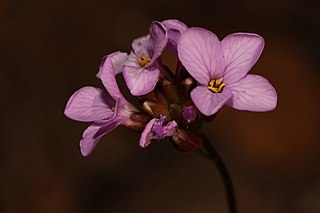
Arabis aculeolata is a species of flowering plant in the mustard family known by the common name Waldo rockcress.

Tephrosia virginiana, also known as goat-rue, goat's rue, catgut, rabbit pea, Virginia tephrosia, hoary pea, and devil's shoestring is a perennial dicot in family Fabaceae. The plant is native to central and eastern North America.
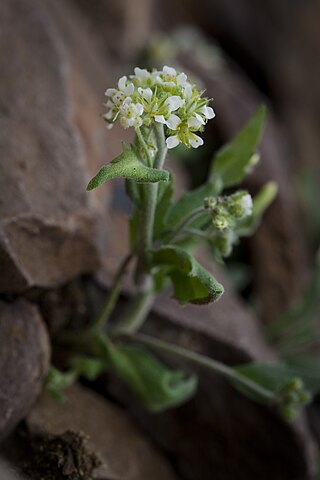
Draba breweri is a species of flowering plant in the family Brassicaceae known by the common names cushion draba, Lanceleaf Draba, Brewer's draba, and Brewer's Whitlow grass. With Draba cana now considered a variety of this species, it is distributed throughout parts of northern and western North America, including much of Canada and the western United States. The less widespread var. breweri is limited to mountainous California and western Nevada.

Monardella purpurea is a species of flowering plant in the mint family known by the common names Siskiyou monardella and serpentine monardella.

Agoseris heterophylla is a liguliferous species in the family Asteraceae known by the common name annual agoseris or mountain dandelion. It is widespread in mostly drier regions of western North America from British Columbia to Baja California.

Enemion biternatum, commonly known as the false rue-anemone, is a spring ephemeral native to moist deciduous woodland in the eastern United States and extreme southern Ontario.

Frasera albomarginata is a species of flowering plant in the gentian family known by the common name desert green gentian, or desert frasera.

















